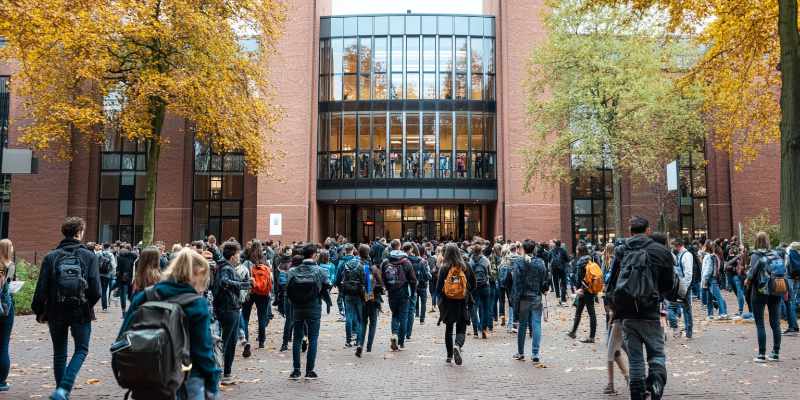Dutch Universities: Prioritizing Foreign Students

In recent years, Dutch universities have increasingly focused on attracting international students, both from within the EU and beyond. While this shift benefits university budgets by bringing in substantial financial gains, it has come at a significant cost to Dutch taxpayers and native students. The growing number of foreign students has placed immense pressure on housing markets, educational quality, and public services in major Dutch cities. As a result, Dutch students are often left in a difficult position, struggling to find affordable housing and facing declining quality in their educational experience.
Financial Incentives: More Foreign Students, More Money
Tuition Fees and Financial Gains
The most immediate financial incentive for universities in attracting foreign students is the substantial difference in tuition fees. Non-EU students, in particular, pay significantly higher tuition fees than their Dutch and EU counterparts. These fees can sometimes be up to three or four times the amount that Dutch or EU students are required to pay (Ministerie van Onderwijs, Cultuur en Wetenschap, 2023). This revenue is a major draw for universities, which are increasingly relying on these fees to fund their operations and expansion efforts.
With the allure of financial stability, universities have started aggressively marketing their programs abroad, targeting international students from countries where higher education is expensive or inaccessible. While the additional income helps universities maintain and expand their facilities, it often results in a system that prioritizes financial gains over the needs of local students. The pressure to attract foreign students also means universities must ensure that their programs are appealing to international markets, sometimes at the expense of local relevance or quality.
Government Funding Based on Student Numbers
In the Netherlands, government funding for universities is largely determined by the number of enrolled students. This means that an increase in student numbers—regardless of whether they are Dutch, EU, or international—directly translates into more financial support from the state (Algemene Rekenkamer, 2023). This system creates a financial incentive for universities to expand their student populations, often without fully considering the impact on educational quality, infrastructure, or local student needs.
However, this reliance on student numbers as a funding mechanism has led to a “growth at all costs” mentality. Universities are under pressure to scale their programs quickly, frequently opening new courses or expanding existing ones to accommodate international students. Unfortunately, this often leads to overcrowded lecture halls and overworked faculty, diminishing the overall quality of education for everyone, including Dutch students.
Housing Crisis: Foreign Students Overrunning Dutch Cities
Overcrowded Student Housing
One of the most visible consequences of the influx of international students is the growing demand for student housing in major Dutch cities such as Amsterdam, Utrecht, and Groningen. These cities are struggling to accommodate the rapidly expanding student population, and this has resulted in a severe shortage of affordable housing. As the number of international students has increased, rental prices for student accommodations have skyrocketed, making it more difficult for Dutch students to find affordable living arrangements (Nederlands Bureau voor Economisch Beleid, 2023).
The housing crisis has reached a point where many Dutch students are either forced to live with their parents well into their university years or commute long distances from smaller towns. On the other hand, international students, who often have the financial backing of their families or sponsorships from their home countries, are often able to secure accommodations more easily. This situation has created an environment where Dutch students are being displaced in their own cities in favor of foreign students who can afford the higher rents.
Displacement of Local Students
The housing crisis has led to a situation where private landlords and housing associations are more likely to prioritize foreign students for available accommodations. This is because foreign students often pay premium rents, which are sometimes subsidized by their home governments. This financial advantage has led to a shift in the housing market, with Dutch students being pushed out in favor of international students who can afford the higher costs. As a result, local students are often left competing for fewer, more expensive options (CBS, 2023).
Furthermore, this displacement isn’t limited to student housing alone. The growing number of foreign students is contributing to a general rise in living costs, which affects both Dutch students and local residents. While international students pay higher rents, the increase in demand for housing also affects local renters, further exacerbating the affordability crisis.
Declining Quality of Education
Large Lecture Halls and Overcrowded Programs
As Dutch universities expand to accommodate the influx of international students, the student-to-teacher ratio has risen significantly. In many programs, lecture halls have become overcrowded, leading to a decline in the quality of education. Professors are stretched thin, with less time to devote to individual students, and courses have become increasingly generalized to cater to larger groups. As a result, students—both Dutch and international—are receiving less personalized attention and support in their studies (Onderwijsinspectie, 2023).
This overcrowding not only affects the learning environment but also reduces the overall quality of university programs. Students are finding it more difficult to engage deeply with the subject matter, and academic performance often suffers as a result. The university experience, once known for its more intimate learning settings, is now characterized by impersonal, large-scale courses that can undermine the educational experience.
English as the Default Language
To appeal to international students, many Dutch universities have made English the primary language of instruction. This shift is not just limited to programs with international relevance but extends to subjects that traditionally had little need for English-language teaching. This move towards English-taught courses has sparked concerns among Dutch students, many of whom prefer to study in their native language. Furthermore, the shift to English may contribute to the decline in the proficiency and use of Dutch in academic and professional settings (Raad voor de Nederlandse Taal en Letteren, 2023).
The widespread use of English in universities also raises questions about the impact on the Dutch cultural and academic identity. As more courses are taught in English, the role of Dutch language and culture in higher education diminishes, potentially diminishing the country’s educational uniqueness in favor of a more globalized, but less locally grounded, system.
Unfair Burden on Dutch Taxpayers
Public Funding for Foreign Students
The financial impact of international students goes beyond tuition fees. EU students, who pay the same tuition fees as Dutch students, also benefit from Dutch student loans and grants. This means that Dutch taxpayers are indirectly subsidizing the education of foreign students who may not contribute back to the Dutch economy once they leave the country after graduation (CPB, 2023). While the influx of EU students does have some economic benefits, such as attracting talent and fostering international collaboration, the long-term financial burden on Dutch taxpayers is becoming increasingly unsustainable.
This situation is compounded by the fact that many of these foreign students do not stay in the Netherlands after completing their studies. They often return to their home countries, taking the skills and knowledge they gained in the Netherlands with them, but without contributing significantly to the Dutch tax system. Dutch taxpayers, in effect, are funding an education system that benefits foreign students who leave without giving back.
Strains on Public Services
The presence of a large number of international students in Dutch cities has placed considerable strain on public services. Healthcare systems, public transport networks, and municipal services are all under pressure as the student population increases. The high concentration of foreign students in major urban centers means that local residents must share these resources with a transient population that does not contribute to funding these services through taxes in the same way that permanent residents do (SCP, 2023).
While universities may generate income from international students, the wider infrastructure and services required to support them often fall on the shoulders of Dutch taxpayers. This creates an imbalance where the costs of hosting large numbers of foreign students are not adequately shared by those who benefit most from their presence.
Who Really Benefits?
Universities and Private Landlords
The primary beneficiaries of the internationalization of Dutch universities are the institutions themselves and private landlords. Universities see their budgets boosted by the higher tuition fees paid by non-EU students, which allows them to fund expansion projects and enhance their global standing. Meanwhile, private landlords capitalize on the housing shortage by charging premium rents to foreign students who are willing and able to pay more for accommodations.
These groups stand to gain financially from the growing presence of international students, but the benefits do not extend to Dutch students or taxpayers, who bear the hidden costs of this strategy.
Dutch Students and Taxpayers Left Behind
Meanwhile, Dutch students are left to cope with overcrowded lecture halls, rising living costs, and an education system that increasingly caters to international students at the expense of their own needs. The competition for housing is fierce, and the declining quality of education is a growing concern. Dutch taxpayers, too, are burdened with the costs of supporting a system that increasingly prioritizes foreign students, while local needs and interests are sidelined.
Conclusion: An Unsustainable System
The financial dependence of Dutch universities on international students has created a series of structural issues that negatively affect Dutch society. The prioritization of foreign students over Dutch students is contributing to overcrowded universities, unaffordable housing, and an unsustainable financial burden on taxpayers. Unless these issues are addressed, the situation is likely to worsen, with Dutch students continuing to face disadvantages in their own country.
References
- Algemene Rekenkamer. (2023). Overheidsfinanciering van universiteiten en studenteninstroom.
- CBS. (2023). Woningmarkt en de invloed van internationale studenten.
- CPB. (2023). De economische impact van EU-studenten in Nederland.
- Ministerie van Onderwijs, Cultuur en Wetenschap. (2023). Onderwijsfinanciering en collegegeldverschillen.
- Nederlands Bureau voor Economisch Beleid. (2023). Effecten van de internationale studentengroei op de Nederlandse economie.
- Onderwijsinspectie. (2023). De gevolgen van massale instroom van studenten voor de onderwijskwaliteit.
- Raad voor de Nederlandse Taal en Letteren. (2023). De impact van Engelstalig onderwijs op de Nederlandse taal.
- SCP. (2023). Druk op publieke voorzieningen door internationale studenten.


















